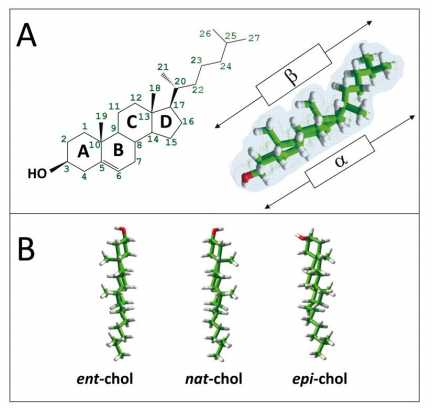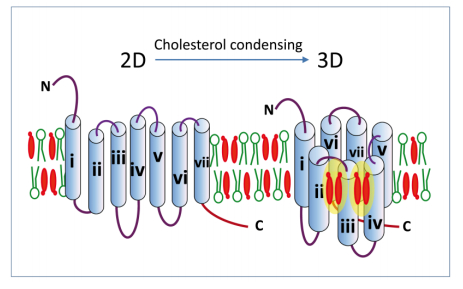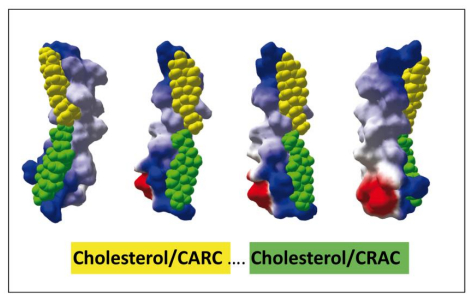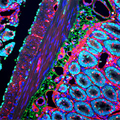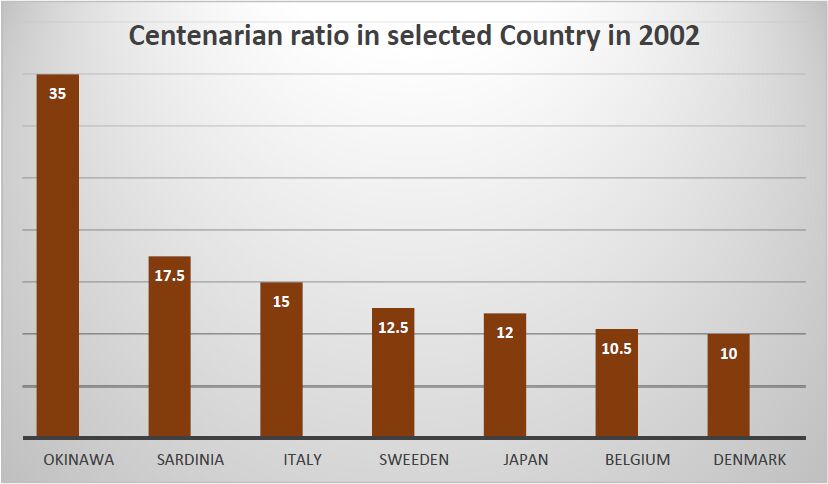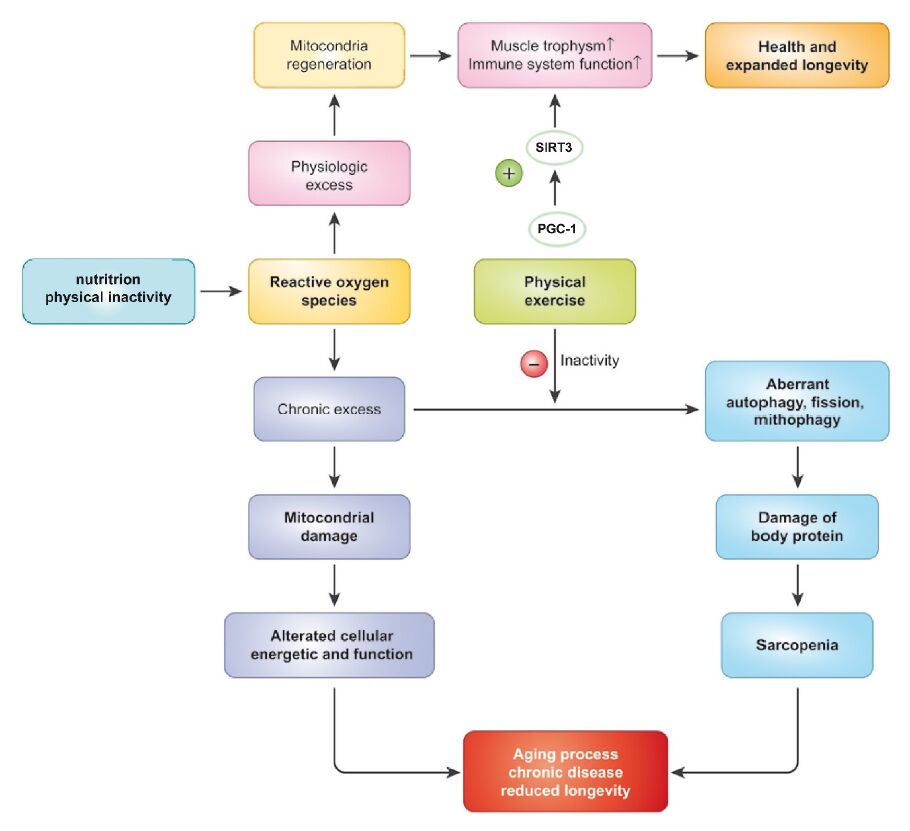|
[1]
|
Barja G (2008) The gene cluster hypothesis of aging and longevity. Biogerontology 9: 57-66. doi: 10.1007/s10522-007-9115-5

|
|
[2]
|
Hayflick L (2007) Biological aging is no longer an unsolved problem. Ann N Y Acad Sci 1100: 1-13. doi: 10.1196/annals.1395.001

|
|
[3]
|
Kirkwood TB (2005) Understanding the odd science of aging. Cell 120: 437-447. doi: 10.1016/j.cell.2005.01.027

|
|
[4]
|
Barja G (2004) Aging in vertebrates, and the effect of caloric restriction: a mitochondrial free radical production-DNA damage mechanism? Biol Rev Camb Philos Soc 79: 235-251. doi: 10.1017/S1464793103006213

|
|
[5]
|
Hutter E, Skovbro M, Lener B, et al. (2007) Oxidative stress and mitochondrial impairment can be separated from lipofuscin accumulation in aged human skeletal muscle. Aging Cell 6: 245-256. doi: 10.1111/j.1474-9726.2007.00282.x

|
|
[6]
|
Ku HH, Brunk UT, Sohal RS (1993) Relationship between mitochondrial superoxide and hydrogen peroxide production and longevity of mammalian species. Free Radic Biol Med 15: 621-627. doi: 10.1016/0891-5849(93)90165-Q

|
|
[7]
|
Lambert AJ, Boysen HM, Buckingham JA, et al. (2007) Low rates of hydrogen peroxide production by isolated heart mitochondria associate with long maximum lifespan in vertebrate homeotherms. Aging Cell 6: 607-618. doi: 10.1111/j.1474-9726.2007.00312.x

|
|
[8]
|
Pamplona R, Portero-Otin M, Requena JR, et al. (1999) A low degree of fatty acid unsaturation leads to lower lipid peroxidation and lipoxidation-derived protein modification in heart mitochondria of the longevous pigeon than in the short-lived rat. Mech Ageing Dev 106: 283-296. doi: 10.1016/S0047-6374(98)00121-3

|
|
[9]
|
Pamplona R, Portero-Otin M, Riba D, et al. (1998) Mitochondrial membrane peroxidizability index is inversely related to maximum life span in mammals. J Lipid Res 39: 1989-1994.
|
|
[10]
|
Pamplona R, Barja G, Portero-Otin M (2002) Membrane fatty acid unsaturation, protection against oxidative stress, and maximum life span: a homeoviscous-longevity adaptation? Ann N Y Acad Sci 959: 475-490.
|
|
[11]
|
Beckman KB, Ames BN (1998) The free radical theory of aging matures. Physiol Rev 78: 547-581.
|
|
[12]
|
Stadtman ER (1992) Protein oxidation and aging. Science 257: 1220-1224. doi: 10.1126/science.1355616

|
|
[13]
|
Balaban RS, Nemoto S, Finkel T (2005) Mitochondria, oxidants, and aging. Cell 120: 483-495. doi: 10.1016/j.cell.2005.02.001

|
|
[14]
|
Droge W (2002) Free radicals in the physiological control of cell function. Physiol Rev 82: 47-95. doi: 10.1152/physrev.00018.2001

|
|
[15]
|
Lobo V, Patil A, Phatak A, et al. (2010) Free radicals, antioxidants and functional foods: Impact on human health. Pharmacogn Rev 4: 118-126. doi: 10.4103/0973-7847.70902

|
|
[16]
|
Liochev SI (2013) Reactive oxygen species and the free radical theory of aging. Free Radic Biol Med 60: 1-4. doi: 10.1016/j.freeradbiomed.2013.02.011

|
|
[17]
|
Cencioni C, Spallotta F, Martelli F, et al. (2013) Oxidative stress and epigenetic regulation in ageing and age-related diseases. Int J Mol Sci 14: 17643-17663. doi: 10.3390/ijms140917643

|
|
[18]
|
Brandes RP, Fleming I, Busse R (2005) Endothelial aging. Cardiovasc Res 66: 286-294. doi: 10.1016/j.cardiores.2004.12.027

|
|
[19]
|
Sohal RS, Weindruch R (1996) Oxidative stress, caloric restriction, and aging. Science 273: 59-63.
|
|
[20]
|
Suliman HB, Piantadosi CA (2014) Mitochondrial biogenesis: regulation by endogenous gases during inflammation and organ stress. Curr Pharm Des 20: 5653-5662. doi: 10.2174/1381612820666140306095717

|
|
[21]
|
Zuo L, He F, Sergakis GG, et al. (2014) Interrelated role of cigarette smoking, oxidative stress, and immune response in COPD and corresponding treatments. Am J Physiol Lung Cell Mol Physiol 307: L205-218. doi: 10.1152/ajplung.00330.2013

|
|
[22]
|
Nathan C, Cunningham-Bussel A (2013) Beyond oxidative stress: an immunologist's guide to reactive oxygen species. Nat Rev Immunol 13: 349-361. doi: 10.1038/nri3423

|
|
[23]
|
Kaeberlein M, Rabinovitch PS, Martin GM (2015) Healthy aging: The ultimate preventative medicine. Science 350: 1191-1193.
|
|
[24]
|
Perls T, Terry D (2003) Genetics of exceptional longevity. Exp Gerontol 38: 725-730. doi: 10.1016/S0531-5565(03)00098-6

|
|
[25]
|
Evert J, Lawler E, Bogan H, et al. (2003) Morbidity profiles of centenarians: survivors, delayers, and escapers. J Gerontol A Biol Sci Med Sci 58: 232-237. doi: 10.1093/gerona/58.3.M232

|
|
[26]
|
Merriwether DA, Clark AG, Ballinger SW, et al. (1991) The structure of human mitochondrial DNA variation. J Mol Evol 33: 543-555. doi: 10.1007/BF02102807

|
|
[27]
|
Greaves LC, Taylor RW (2006) Mitochondrial DNA mutations in human disease. IUBMB Life 58: 143- 151. doi: 10.1080/15216540600686888

|
|
[28]
|
Chinnery PF, Samuels DC, Elson J, et al. (2002) Accumulation of mitochondrial DNA mutations in ageing, cancer, and mitochondrial disease: is there a common mechanism? Lancet 360: 1323-1325. doi: 10.1016/S0140-6736(02)11310-9

|
|
[29]
|
Tanaka M, Gong J, Zhang J, et al. (2000) Mitochondrial genotype associated with longevity and its inhibitory effect on mutagenesis. Mech Ageing Dev 116: 65-76. doi: 10.1016/S0047-6374(00)00149-4

|
|
[30]
|
Hulbert AJ, Pamplona R, Buffenstein R, et al. (2007) Life and death: metabolic rate, membrane composition, and life span of animals. Physiol Rev 87: 1175-1213. doi: 10.1152/physrev.00047.2006

|
|
[31]
|
Munro D, Blier PU (2012) The extreme longevity of Arctica islandica is associated with increased peroxidation resistance in mitochondrial membranes. Aging Cell 11: 845-855. doi: 10.1111/j.1474-9726.2012.00847.x

|
|
[32]
|
Barja G, Herrero A (2000) Oxidative damage to mitochondrial DNA is inversely related to maximum life span in the heart and brain of mammals. FASEB J 14: 312-318.
|
|
[33]
|
Valls C ,Castelluccio C, Fato R, et al. (1994) Protective effect of exogenous coenzyme q against damage by Adriamycin n perfused rat liver. Biochem Mol Biol Int 33: 633-642.
|
|
[34]
|
Beyer RE, Segura-Aguilar J, Di Bernardo S, et al. (1996) The role of DT-diaphorase in the maintenance of the reduced antioxidant form of coenzyme Q in membrane systems. Proc Natl Acad Sci U S A 93: 2528-2532 doi: 10.1073/pnas.93.6.2528

|
|
[35]
|
Trounce I, Byrne E, Marzuki S (1989) Decline in skeletal muscle mitochondrial respiratory chain function: possible factor in ageing. Lancet 1:637-639.
|
|
[36]
|
37. Genova ML, Lenaz G (2015) The Interplay Between Respiratory Supercomplexes and ROS in Aging. Antioxid Redox Signal 23: 208-238. doi: 10.1089/ars.2014.6214

|
|
[37]
|
38. Ristow M, Schmeisser S (2011) Extending life span by increasing oxidative stress. Free Radic Biol Med 51: 327-336. doi: 10.1016/j.freeradbiomed.2011.05.010

|
|
[38]
|
39. Wohlgemuth SE, Seo AY, Marzetti E, et al. (2010) Skeletal muscle autophagy and apoptosis during aging: effects of calorie restriction and life-long exercise. Exp Gerontol 45: 1148. doi: 10.1016/j.exger.2009.11.002

|
|
[39]
|
40. Hood DA (2001) Invited Review: contractile activity-induced mitochondrial biogenesis in skeletal muscle. J Appl Physiol 90: 1137-1157.
|
|
[40]
|
41. Klingenspor M (2003) Cold-induced recruitment of brown adipose tissue thermogenesis. Exp Physiol 88: 141-148. doi: 10.1113/eph8802508

|
|
[41]
|
42. Civitarese AE, Carling S, Heilbronn LK, et al. (2007) Calorie restriction increases muscle mitochondrial biogenesis in healthy humans. PLoS Med 4: e76. doi: 10.1371/journal.pmed.0040076

|
|
[42]
|
43. Ristow M, Zarse K (2010) How increased oxidative stress promotes longevity and metabolic health: the concept of mitochondrial hormesis (mitohormesis). Exp Gerontol 45: 410-418. doi: 10.1016/j.exger.2010.03.014

|
|
[43]
|
44. Ristow M, Schmeisser S (2011) Extending life span by increasing oxidative stress. Free Radic Biol Med 51: 327–336. doi: 10.1016/j.freeradbiomed.2011.05.010

|
|
[44]
|
45. Sadowska-Bartosz I, Bartosz G (2014) Effect of antioxidants supplementation on aging and longevity. Biomed Res Int 2014: 404680.
|
|
[45]
|
46. Alexander SP, Benson HE, Faccenda E, et al. (2013) The Concise Guide to pharmacology 2013/14: nuclear hormone receptors. Br J Pharmacol 170: 1652-1675. doi: 10.1111/bph.12448

|
|
[46]
|
47. Goffart S, Wiesner RJ (2003) Regulation and co-ordination of nuclear gene expression during mitochondrial biogenesis. Exp Physiol 88: 33-40. doi: 10.1113/eph8802500

|
|
[47]
|
48. Scarpulla RC (2008) Nuclear control of respiratory chain expression by nuclear respiratory factors and PGC-1-related coactivator. Ann N Y Acad Sci 11 321-334.
|
|
[48]
|
49. Brenmoehl J, Hoeflich A (2013) Dual control of mitochondrial biogenesis by sirtuin 1 and sirtuin 3. Mitochondrion 13: 755-761. doi: 10.1016/j.mito.2013.04.002

|
|
[49]
|
50. Kong X, Wang R, Xue Y, et al. (2010) Sirtuin 3, a new target of PGC-1alpha, plays an important role in the suppression of ROS and mitochondrial biogenesis. PLoS One 5: e11707. doi: 10.1371/journal.pone.0011707

|
|
[50]
|
51. Yan W, Zhang H, Liu P, et al. (2013) Impaired mitochondrial biogenesis due to dysfunctional adiponectin-AMPK-PGC-1alpha signaling contributing to increased vulnerability in diabetic heart. Basic Res Cardiol 108: 329. doi: 10.1007/s00395-013-0329-1

|
|
[51]
|
52. Soriano FX, Liesa M, Bach D, et al. (2006) Evidence for a mitochondrial regulatory pathway defined by peroxisome proliferator-activated receptor-gamma coactivator-1 alpha, estrogen-related receptor-alpha, and mitofusin 2. Diabetes 55: 1783-1791.
|
|
[52]
|
53. Bach D, Pich S, Soriano FX, et al. (2003) Mitofusin-2 determines mitochondrial network architecture and mitochondrial metabolism. A novel regulatory mechanism altered in obesity. J Biol Chem 278: 17190-17197.
|
|
[53]
|
54. Nisoli E, Valerio A (2014) Healthspan and longevity in mammals: a family game for cellular organelles? Curr Pharm Des 20: 5663-5670. doi: 10.2174/1381612820666140306093651

|
|
[54]
|
55. Rato L, Duarte AI, Tomas GD, et al. (2014) Pre-diabetes alters testicular PGC1-alpha/SIRT3 axis modulating mitochondrial bioenergetics and oxidative stress. Biochim Biophys Acta 1837: 335-344. doi: 10.1016/j.bbabio.2013.12.008

|
|
[55]
|
56. Golan R, Scovell JM, Ramasamy R (2015) Age-related testosterone decline is due to waning of both testicular and hypothalamic-pituitary function. Aging Male 18: 201-204. doi: 10.3109/13685538.2015.1052392

|
|
[56]
|
57. El Khoudary SR, Santoro N, Chen HY, et al. (2016) Trajectories of estradiol and follicle-stimulating hormone over the menopause transition and early markers of atherosclerosis after menopause. Eur J Prev Cardiol 23: 694-703. doi: 10.1177/2047487315607044

|
|
[57]
|
58. Psarra AM, Sekeris CE (2008) Steroid and thyroid hormone receptors in mitochondria. IUBMB Life 60: 210-223.
|
|
[58]
|
59. Guo W, Wong S, Li M, et al. (2012) Testosterone plus low-intensity physical training in late life improves functional performance, skeletal muscle mitochondrial biogenesis, and mitochondrial quality control in male mice. PLoS One 7:51180. doi: 10.1371/journal.pone.0051180

|
|
[59]
|
60. Hioki T, Suzuki S, Morimoto M, et al. (2014) Brain testosterone deficiency leads to down-regulation of mitochondrial gene expression in rat hippocampus accompanied by a decline in peroxisome proliferator-activated receptor-gamma coactivator 1alpha expression. J Mol Neurosci 52: 531-537. doi: 10.1007/s12031-013-0108-3

|
|
[60]
|
61. Capllonch-Amer G, Sbert-Roig M, Galmes-Pascual BM, et al. (2014) Estradiol stimulatesmitochondrial biogenesis and adiponectin expression in skeletal muscle. J Endocrinol 221: 391-403. doi: 10.1530/JOE-14-0008

|
|
[61]
|
62. Capllonch-Amer G, Llado I, Proenza AM, et al. (2014) Opposite effects of 17-beta estradiol and testosterone on mitochondrial biogenesis and adiponectin synthesis in white adipocytes. J Mol Endocrinol 52: 203-214.
|
|
[62]
|
63. Qiao L, Kinney B, Yoo HS, et al. (2012) Adiponectin increases skeletal muscle mitochondrial biogenesis by suppressing mitogen-activated protein kinase phosphatase-1. Diabetes 61: 1463- 1470. doi: 10.2337/db11-1475

|
|
[63]
|
64. Casas F, Pessemesse L, Grandemange S, et al. (2009) Overexpression of the mitochondria receptor induces skeletal muscle atrophy during aging. PLoS One 4: e5. doi: 10.1371/journal.pone.0005631

|
|
[64]
|
65. Skov V, Glintborg D, Knudsen S, et al. (2007) Reduced expression of nuclear-encoded genes involved in mitochondrial oxidative metabolism in skeletal muscle of insulin-resistant women with polycystic ovary syndrome. Diabetes 56: 2349-2355. doi: 10.2337/db07-0275

|
|
[65]
|
66. Wang M, Wang XC, Zhang ZY, et al. (2010) Impaired mitochondrial oxidative phosphorylation in multiple insulin-sensitive tissues of humans with type 2 diabetes mellitus. J Int Med Res 38: 769- 781.
|
|
[66]
|
67. Boirie Y (2003) Insulin regulation of mitochondrial proteins and oxidative phosphorylation in human muscle. Trends Endocrinol Metab 14: 393-394. doi: 10.1016/j.tem.2003.09.002

|
|
[67]
|
68. Asmann YW, Stump CS, Short KR, et al. (2006) Skeletal muscle mitochondrial functions, mitochondrial DNA copy numbers, and gene transcript profiles in type 2 diabetic and nondiabetic subjects at equal levels of low or high insulin and euglycemia. Diabetes 55: 3309-3319.
|
|
[68]
|
69. Pei H, Yang Y, Zhao H, et al. (2016) The Role of Mitochondrial Functional Proteins in ROS Production in Ischemic Heart Diseases. Oxid Med Cell Longev 2016: 5470457.
|
|
[69]
|
70. Gilgun-Sherki Y, Melamed E, Offen D (2001) Oxidative stress induced-neurodegenerative diseases: the need for antioxidants that penetrate the blood brain barrier. Neuropharmacology 40: 959-975. doi: 10.1016/S0028-3908(01)00019-3

|
|
[70]
|
71. Lightowlers RN, Taylor RW, Turnbull DM (2015) Mutations causing mitochondrial disease: What is new and what challenges remain? Science 349: 1494-1499
|
|
[71]
|
72. Uittenbogaard M, Chiaramello A (2014) Mitochondrial biogenesis: a therapeutic target for neurodevelopmental disorders and neurodegenerative diseases. Curr Pharm Des 20: 5574-5593. doi: 10.2174/1381612820666140305224906

|
|
[72]
|
73. Wu SB, Ma YS, Wu YT, et al. (2010) Mitochondrial DNA mutation-elicited oxidative stress, oxidative damage, and altered gene expression in cultured cells of patients with MERRF syndrome. Mol Neurobiol 41: 256-266.
|
|
[73]
|
74. Powers SK, Jackson MJ (2008) Exercise-induced oxidative stress: cellular mechanisms and impact on muscle force production. Physiol Rev 88: 1243-1276. doi: 10.1152/physrev.00031.2007

|
|
[74]
|
75. Tsutsui H, Kinugawa S, Matsushima S (2011) Oxidative stress and heart failure. Am J Physiol Heart Circ Physiol 301: H2181-2190 doi: 10.1152/ajpheart.00554.2011

|
|
[75]
|
76. Burgoyne JR, Mongue-Din H, Eaton P, et al. (2012) Redox signaling in cardiac physiology and pathology. Circ Res 111: 1091-1106 doi: 10.1161/CIRCRESAHA.111.255216

|
|
[76]
|
77. Sag CM, Kohler AC, Anderson ME, et al. (2011) CaMKII-dependent SR Ca leak contributes to doxorubicin-induced impaired Ca handling in isolated cardiac myocytes. J Mol Cell Cardiol 51: 749- 759. doi: 10.1016/j.yjmcc.2011.07.016

|
|
[77]
|
78. Kim SJ, Cheresh P, Jablonski RP, et al. (2015) The Role of Mitochondrial DNA in Mediating Alveolar Epithelial Cell Apoptosis and Pulmonary Fibrosis. Int J Mol Sci 16: 21486-21519. doi: 10.3390/ijms160921486

|
|
[78]
|
79. Rato L, Alves MG, Cavaco JE, et al. (2014) High-energy diets: a threat for male fertility? Obes Rev 15: 996-1007. doi: 10.1111/obr.12226

|
|
[79]
|
80. Rato L, Alves MG, Dias TR, et al. (2013) High-energy diets may induce a pre-diabetic state altering testicular glycolytic metabolic profile and male reproductive parameters. Andrology 1: 495-504. doi: 10.1111/j.2047-2927.2013.00071.x

|
|
[80]
|
81. Wu YT, Wu SB, Wei YH (2014) Metabolic reprogramming of human cells in response to oxidative stress: implications in the pathophysiology and therapy of mitochondrial diseases. Curr Pharm Des 20: 5510-5526. doi: 10.2174/1381612820666140306103401

|
|
[81]
|
82. Wang Y, Oxer D, Hekimi S (2015) Mitochondrial function and lifespan of mice with controlled ubiquinone biosynthesis. Nat Commun 6: 6393. doi: 10.1038/ncomms7393

|
|
[82]
|
83. Zuo L, Nogueira L, Hogan MC (2011) Reactive oxygen species formation during tetanic contractions in single isolated Xenopus myofibers. J Appl Physiol (1985) 111: 898-904. doi: 10.1152/japplphysiol.00398.2011

|
|
[83]
|
84. Zuo L, Shiah A, Roberts WJ, et al. (2013) Low Po(2) conditions induce reactive oxygen species formation during contractions in single skeletal muscle fibers. Am J Physiol Regul Integr Comp Physiol 304: R1009-1016.
|
|
[84]
|
85. Zuo L, Best TM, Roberts WJ, et al. (2015) Characterization of reactive oxygen species in diaphragm. Acta Physiol (Oxf) 213: 700-710. doi: 10.1111/apha.12410

|
|
[85]
|
86. Reid MB, Moylan JS (2011) Beyond atrophy: redox mechanisms of muscle dysfunction in chronic inflammatory disease. J Physiol 589: 2171-2179. doi: 10.1113/jphysiol.2010.203356

|
|
[86]
|
87. Merry TL, Lynch GS, McConell GK (2010) Downstream mechanisms of nitric oxide-mediated skeletal muscle glucose uptake during contraction. Am J Physiol Regul Integr Comp Physiol 299: R1656- 1665. doi: 10.1152/ajpregu.00433.2010

|
|
[87]
|
88. Powers SK, Talbert EE, Adhihetty PJ (2011) Reactive oxygen and nitrogen species as intracellular signals in skeletal muscle. J Physiol 589: 2129-2138. doi: 10.1113/jphysiol.2010.201327

|
|
[88]
|
89. Powers SK, Duarte J, Kavazis AN, et al. (2010) Reactive oxygen species are signalling molecules for skeletal muscle adaptation. Exp Physiol 95: 1-9. doi: 10.1113/expphysiol.2009.050526

|
|
[89]
|
90. Bassel-Duby R, Olson EN (2006) Signaling pathways in skeletal muscle remodeling. Annu Rev Biochem 75: 19-37. doi: 10.1146/annurev.biochem.75.103004.142622

|
|
[90]
|
91. Vollaard NB, Shearman JP, Cooper CE (2005) Exercise-induced oxidative stress:myths, realities and physiological relevance. Sports Med 35: 1045-1062. doi: 10.2165/00007256-200535120-00004

|
|
[91]
|
92. Barbieri E, Sestili P (2012) Reactive oxygen species in skeletal muscle signaling. J Signal Transduct 2012: 982794.
|
|
[92]
|
93. Close GL, Ashton T, Cable T, et al. (2004) Eccentric exercise, isokinetic muscle torque and delayed onset muscle soreness: the role of reactive oxygen species. Eur J Appl Physiol 91: 615-621. doi: 10.1007/s00421-003-1012-2

|
|
[93]
|
94. Kuwahara H, Horie T, Ishikawa S, et al. (2010) Oxidative stress in skeletal muscle causes severe disturbance of exercise activity without muscle atrophy. Free Radic Biol Med 48: 1252-1262. doi: 10.1016/j.freeradbiomed.2010.02.011

|
|
[94]
|
95. Zuo L, Pannell BK (2015) Redox Characterization of Functioning Skeletal Muscle. Front Physiol 6: 338.
|
|
[95]
|
96. Lustgarten MS, Jang YC, Liu Y, et al. (2011) MnSOD deficiency results in elevated oxidative stress and decreased mitochondrial function but does not lead to muscle atrophy during aging. Aging Cell 10: 493-505. doi: 10.1111/j.1474-9726.2011.00695.x

|
|
[96]
|
97. Gomez-Cabrera MC, Domenech E, Vina J (2008) Moderate exercise is an antioxidant: upregulation of antioxidant genes by training. Free Radic Biol Med 44: 126-131. doi: 10.1016/j.freeradbiomed.2007.02.001

|
|
[97]
|
98. Adhihetty PJ, Ljubicic V, Hood DA (2007) Effect of chronic contractile activity on SS and IMF mitochondrial apoptotic susceptibility in skeletal muscle. Am J Physiol Endocrinol Metab 292: E748- 755.
|
|
[98]
|
99. Joseph AM, Adhihetty PJ, Leeuwenburgh C (2015) Beneficial effects of exercise on age-related mitochondrial dysfunction and oxidative stress in skeletal muscle. J Physiol 594: 5105-5123.
|
|
[99]
|
100. Russell AP, Foletta VC, Snow RJ, et al. (2014) Skeletal muscle mitochondria: a major player in exercise, health and disease. Biochim Biophys Acta 1840: 1276-1284. doi: 10.1016/j.bbagen.2013.11.016

|
|
[100]
|
101. Sachdev S, Davies KJ (2008) Production, detection, and adaptive responses to free radicals in exercise. Free Radic Biol Med 44: 215-223.
|
|
[101]
|
102. Mrakic-Sposta S, Gussoni M, Moretti S, et al. (2015) Effects of Mountain Ultra-Marathon Running on ROS Production and Oxidative Damage by Micro-Invasive Analytic Techniques. PLoS One 10: e0141780. doi: 10.1371/journal.pone.0141780

|
|
[102]
|
103. Vezzoli A, Pugliese L, Marzorati M, et al. (2014) Time-course changes of oxidative stress response to high-intensity discontinuous training versus moderate-intensity continuous training in masters runners. PLoS One 9: e87506. doi: 10.1371/journal.pone.0087506

|
|
[103]
|
104. Little JP, Safdar A, Wilkin GP, et al. (2010) A practical model of low-volume high-intensity interval training induces mitochondrial biogenesis in human skeletal muscle: potential mechanisms. J Physiol 588: 1011-1022. doi: 10.1113/jphysiol.2009.181743

|
|
[104]
|
105. Hood MS, Little JP, Tarnopolsky MA, et al. (2011) Low-volume interval training improves muscle oxidative capacity in sedentary adults. Med Sci Sports Exerc 43: 1849-1856. doi: 10.1249/MSS.0b013e3182199834

|
|
[105]
|
106. Powers SK, Smuder AJ, Judge AR (2012) Oxidative stress and disuse muscle atrophy: cause or consequence? Curr Opin Clin Nutr Metab Care 15: 240-245. doi: 10.1097/MCO.0b013e328352b4c2

|
|
[106]
|
107. Powers SK, Kavazis AN, McClung JM (2007) Oxidative stress and disuse muscle atrophy. J Appl Physiol 102: 2389-2397. doi: 10.1152/japplphysiol.01202.2006

|
|
[107]
|
108. Owers SK, Hudson MB, Nelson WB, et al. (2011) Mitochondria-targeted antioxidants protect against mechanical ventilation-induced diaphragm weakness. Crit Care Med 39: 1749-1759. doi: 10.1097/CCM.0b013e3182190b62

|
|
[108]
|
109. Powers SK, Kavazis AN, DeRuisseau KC (2005) Mechanisms of disuse muscle atrophy: role of oxidative stress. Am J Physiol Regul Integr Comp Physiol 288: R337-344.
|
|
[109]
|
110. Pellegrino MA, Desaphy JF, Brocca L, et al. (2011) Redox homeostasis, oxidative stress and disuse muscle atrophy. J Physiol 589: 2147-2160. doi: 10.1113/jphysiol.2010.203232

|
|
[110]
|
111. Ghosh S, Karin M (2002) Missing pieces in the NF-B puzzle. Cell Suppl 109: S81-S96.
|
|
[111]
|
112. Powers SK, Smuder AJ, Criswell DS (2011) Mechanistic links between oxidative stress and disuse muscle atrophy. Antioxid Redox Signal 15: 2519-2528. doi: 10.1089/ars.2011.3973

|
|
[112]
|
113. Muller FL, Song W, Jang YC, et al. (2007) Denervation-induced skeletal muscle atrophy is associated with increased mitochondrial ROS production. Am J Physiol Regul Integr Comp Physiol 293: R1159- 1168.
|
|
[113]
|
114. Wong RSY (2011) Apoptosis in cancer: from pathogenesis to treatment. JECCR 30: 87.
|
|
[114]
|
115. Green DR, Kroemer G (2004) The pathophysiology of mitochondrial cell death. Science 305: 626-629. doi: 10.1126/science.1099320

|
|
[115]
|
116. Thornberry NA, Lazebnik Y (1998) Caspases: enemies within. Science 281: 1312-1316.
|
|
[116]
|
117. Braga M, Sinha Hikim AP, Datta S, et al. (2008) Involvement of oxidative stress and caspase 2- mediated intrinsic pathway signaling in age-related increase in muscle cell apoptosis in mice. Apoptosis 13: 822-832. doi: 10.1007/s10495-008-0216-7

|
|
[117]
|
118. Siu PM, Wang Y, Alway SE (2009) Apoptotic signaling induced by H2O2-mediated oxidative stress in differentiated C2C12 myotubes. Life Sci 84: 468-481. doi: 10.1016/j.lfs.2009.01.014

|
|
[118]
|
119. Whidden MA, Smuder AJ, Wu M, et al. (2010) Oxidative stress is required for mechanical ventilation-induced protease activation in the diaphragm. J Appl Physiol (1985) 108: 1376-1382. doi: 10.1152/japplphysiol.00098.2010

|
|
[119]
|
120. Du J, Wang X, Miereles C, et al. (2004) Activation of caspase-3 is an initial step triggering accelerated muscle proteolysis in catabolic conditions. J Clin Invest 113: 115-123. doi: 10.1172/JCI18330

|
|
[120]
|
121. McClung JM, Kavazis AN, DeRuisseau KC, et al. (2007) Caspase-3 regulation of diaphragm myonuclear domain during mechanical ventilation-induced atrophy. Am J Respir Crit Care Med 175:150-159. doi: 10.1164/rccm.200601-142OC

|
|
[121]
|
122. Radak Z, Chung HY, Goto S (2005) Exercise and hormesis: oxidative stress-related adaptation for successful aging. Biogerontology 6: 71-75. doi: 10.1007/s10522-004-7386-7

|
|
[122]
|
123. Bishop NA, Guarente L (2007) Genetic links between diet and lifespan: shared mechanisms from yeast to humans. Nat Rev Genet 8: 835-844.
|
|
[123]
|
124. Willcox BJ, Willcox DC, Todoriki H, et al. (2007) Caloric restriction, the traditional Okinawan diet, and healthy aging: the diet of the world's longest-lived people and its potential impact on morbidity and life span. Ann N Y Acad Sci 1114: 434-455. doi: 10.1196/annals.1396.037

|
|
[124]
|
125. Fontana L, Partridge L, Longo VD (2010) Extending healthy life span--from yeast to humans. Science 328: 321-326. doi: 10.1126/science.1172539

|
|
[125]
|
126. Spindler SR (2010) Caloric restriction: from soup to nuts. Ageing Res Rev 9: 324-353. doi: 10.1016/j.arr.2009.10.003

|
|
[126]
|
127. Sohal RS, Agarwal S, Candas M, et al. (1994) Effect of age and caloric restriction on DNA oxidative damage in different tissues of C57BL/6 mice. Mech Ageing Dev 76: 215-224. doi: 10.1016/0047-6374(94)91595-4

|
|
[127]
|
128. Barja G (2002) Endogenous oxidative stress: relationship to aging, longevity and caloric restriction. Ageing Res Rev 1: 397-411. doi: 10.1016/S1568-1637(02)00008-9

|
|
[128]
|
129. Matsuo M, Gomi F, Kuramoto K, et al. (1993) Food restriction suppresses an age-dependent increase in the exhalation rate of pentane from rats: a longitudinal study. J Gerontol 48: B133-136. doi: 10.1093/geronj/48.4.B133

|
|
[129]
|
130. Gredilla R, Sanz A, Lopez-Torres M, et al. (2001) Caloric restriction decreases mitochondrial free radical generation at complex I and lowers oxidative damage to mitochondrial DNA in the rat heart. FASEB J 15: 1589-1591.
|
|
[130]
|
131. Masoro EJ (1988) Physiological system markers of aging. Exp Gerontol 23: 391-397. doi: 10.1016/0531-5565(88)90043-5

|
|
[131]
|
132. Miller RA, Buehner G, Chang Y, et al. (2005) Methionine-deficient diet extends mouse lifespan, slows immune and lens aging, alters glucose, T4, IGF-I and insulin levels, and increases hepatocyte MIF levels and stress resistance. Aging Cell 4: 119-125. doi: 10.1111/j.1474-9726.2005.00152.x

|
|
[132]
|
133. Speakman JR, Mitchell SE (2011) Caloric restriction. Mol Aspects Med 32: 159-221. doi: 10.1016/j.mam.2011.07.001

|
|
[133]
|
134. Colman RJ, Anderson RM, Johnson SC, et al. (2009) Caloric restriction delays disease onset and mortality in rhesus monkeys. Science 325: 201-204. doi: 10.1126/science.1173635

|
|
[134]
|
135. Barja G (2013) Updating the mitochondrial free radical theory of aging: an integrated view, key aspects, and confounding concepts. Antioxid Redox Signal 19: 1420-1445. doi: 10.1089/ars.2012.5148

|
|
[135]
|
136. Lambert AJ, Merry BJ (2004) Effect of caloric restriction on mitochondrial reactive oxygen species production and bioenergetics: reversal by insulin. Am J Physiol Regul Integr Comp Physiol 286: R71- 79.
|
|
[136]
|
137. Rebrin I, Kamzalov S, Sohal RS (2003) Effects of age and caloric restriction on glutathione redox state in mice. Free Radic Biol Med 35: 626-635. doi: 10.1016/S0891-5849(03)00388-5

|
|
[137]
|
138. Dubey A, Forster MJ, Lal H, et al. (1996) Effect of age and caloric intake on protein oxidation in different brain regions and on behavioral functions of the mouse. Arch Biochem Biophys 333: 189- 197.
|
|
[138]
|
139. Lass A, Sohal BH, Weindruch R, et al. (1998) Caloric restriction prevents age-associated accrual of oxidative damage to mouse skeletal muscle mitochondria. Free Radic Biol Med 25: 1089-1097. doi: 10.1016/S0891-5849(98)00144-0

|
|
[139]
|
140. Heilbronn LK, de Jonge L, Frisard MI, et al. (2006) Effect of 6-month calorie restriction on biomarkers of longevity, metabolic adaptation, and oxidative stress in overweight individuals: a randomized controlled trial. JAMA 295: 1539-1548.
|
|
[140]
|
141. Fontana L, Meyer TE, Klein S, et al. (2004) Long-term calorie restriction is highly effective in reducing the risk for atherosclerosis in humans. Proc Natl Acad Sci U S A 101: 6659-6663. doi: 10.1073/pnas.0308291101

|
|
[141]
|
142. Yu BP (1996) Aging and oxidative stress: modulation by dietary restriction. Free Radic Biol Med 21: 651-668. doi: 10.1016/0891-5849(96)00162-1

|
|
[142]
|
143. Masoro EJ (2009) Caloric restriction-induced life extension of rats and mice: a critique of proposed mechanisms. Biochim Biophys Acta 1790: 1040-1048. doi: 10.1016/j.bbagen.2009.02.011

|
|
[143]
|
144. Merry BJ (2002) Molecular mechanisms linking calorie restriction and longevity. Int J Biochem Cell Biol 34: 1340-1354.
|
|
[144]
|
145. McDonald RB, Ramsey JJ (2010) Honoring Clive McCay and 75 years of calorie restriction research. J Nutr 140: 1205-1210. doi: 10.3945/jn.110.122804

|
|
[145]
|
146. Li Y, Daniel M, Tollefsbol TO (2011) Epigenetic regulation of caloric restriction in aging. BMC Med 9: 98. doi: 10.1186/1741-7015-9-98

|
|
[146]
|
147. Ostergaard JN, Gronbaek M, Schnohr P, et al. (2010) Combined effects of weight loss and physical activity on all-cause mortality of overweight men and women. Int J Obes (Lond) 34: 760-769. doi: 10.1038/ijo.2009.274

|
|
[147]
|
148. Nanri A, Mizoue T, Takahashi Y, et al. (2010) Weight change and all-cause, cancer and cardiovascular disease mortality in Japanese men and women: the Japan Public Health Center- Based Prospective Study. Int J Obes (Lond) 34: 348-356. doi: 10.1038/ijo.2009.234

|
|
[148]
|
149. Romero-Corral A, Montori VM, Somers VK, et al. (2006) Association of bodyweight with total mortality and with cardiovascular events in coronary artery disease: a systematic review of cohort studies. Lancet 368: 666-678.
|
|
[149]
|
150. De Schutter A, Lavie CJ, Patel DA, et al. (2013) Relation of body fat categories by Gallagher classification and by continuous variables to mortality in patients with coronary heart disease. Am J Cardiol 111: 657-660. doi: 10.1016/j.amjcard.2012.11.013

|
|
[150]
|
151. Lavie CJ, De Schutter A, Parto P, et al. (2016) Obesity and Prevalence of Cardiovascular Diseases and Prognosis-The Obesity Paradox Updated. Prog Cardiovasc Dis 58: 537-547. doi: 10.1016/j.pcad.2016.01.008

|
|
[151]
|
152. Dellagrana RA, Guglielmo LG, Santos BV, et al. (2015) Physiological, anthropometric, strength, and muscle power characteristics correlates with running performance in young runners. J Strength Cond Res 29: 1584-1591. doi: 10.1519/JSC.0000000000000784

|
|
[152]
|
153. Sabino PG, Silva BM, Brunetto AF (2010) Nutritional status is related to fat-free mass, exercise capacity and inspiratory strength in severe chronic obstructive pulmonary disease patients. Clinics (Sao Paulo) 65: 599-605. doi: 10.1590/S1807-59322010000600007

|
|
[153]
|
154. Ruiz JR, Sui X, Lobelo F, et al. (2008) Association between muscular strength and mortality in men: prospective cohort study. BMJ 337: a439. doi: 10.1136/bmj.a439

|
|
[154]
|
155. Deutz NE, Bauer JM, Barazzoni R, et al. (2014) Protein intake and exercise for optimal muscle function with aging: Recommendations from the ESPEN Expert Group. Clin Nutr 33: 929-936. doi: 10.1016/j.clnu.2014.04.007

|
|
[155]
|
156. Izawa KP, Watanabe S, Hirano Y, et al. (2014) The relation between Geriatric Nutritional Risk Index and muscle mass, muscle strength, and exercise capacity in chronic heart failure patients. Int J Cardiol 177: 1140-1141. doi: 10.1016/j.ijcard.2014.08.045

|
|
[156]
|
157. Victor VM, Rovira-Llopis S, Saiz-Alarcon V, et al. (2014) Altered mitochondrial function and oxidative stress in leukocytes of anorexia nervosa patients. PLoS One 9: e106463. doi: 10.1371/journal.pone.0106463

|
|
[157]
|
158. Rani V, Deep G, Singh RK, et al. (2016) Oxidative stress and metabolic disorders: Pathogenesis and therapeutic strategies. Life Sci 148: 183-193. doi: 10.1016/j.lfs.2016.02.002

|
|
[158]
|
159. Keaney JF, Jr., Larson MG, Vasan RS, et al. (2003) Obesity and systemic oxidative stress: clinical correlates of oxidative stress in the Framingham Study. Arterioscler Thromb Vasc Biol 23: 434-439. doi: 10.1161/01.ATV.0000058402.34138.11

|
|
[159]
|
160. Olusi SO (2002) Obesity is an independent risk factor for plasma lipid peroxidation and depletion of erythrocyte cytoprotectic enzymes in humans. Int J Obes Relat Metab Disord 26: 11164. doi: 10.1038/sj.ijo.0802066

|
|
[160]
|
161. Prieto D, Contreras C, Sanchez A (2014) Endothelial dysfunction, obesity and insulin resistance. Curr Vasc Pharmacol 12: 412-426.
|
|
[161]
|
162. Williams IL, Wheatcroft SB, Shah AM, et al. (2002) Obesity, atherosclerosis and the vascular endothelium: mechanisms of reduced nitric oxide bioavailability in obese humans. Int J Obes Relat Metab Disord 26: 754-764. doi: 10.1038/sj.ijo.0801995

|
|
[162]
|
163. Harrison DG (1997) Cellular and molecular mechanisms of endothelial cell dysfunction. J Clin Invest 100: 2153-2157.
|
|
[163]
|
164. Hausman GJ, Barb CR (2010) Adipose tissue and the reproductive axis: biological aspects. Endocr Dev 19: 31-44.
|
|
[164]
|
165. Henry BA, Clarke IJ (2008) Adipose tissue hormones and the regulation of food intake. J Neuroendocrinol 20: 842-910. doi: 10.1111/j.1365-2826.2008.1730.x

|
|
[165]
|
166. Small CJ, Stanley SA, Bloom SR (2002) Appetite control and reproduction: leptin and beyond. Semin Reprod Med 20: 389-398. doi: 10.1055/s-2002-36712

|
|
[166]
|
167. Rahmouni K (2007) Differential Control of the Sympathetic Nervous System by Leptin: Implications for Obesity. Clin Exp Pharmacol Physiol Suppl 34: S8-S10. doi: 10.1111/j.1440-1681.2007.04760.x

|
|
[167]
|
168. Korda M, Kubant R, Patton S, et al. (2008) Leptin-induced endothelial dysfunction in obesity. Am J Physiol Heart Circ Physiol 295: H1514-1521. doi: 10.1152/ajpheart.00479.2008

|
|
[168]
|
169. Blanca AJ, Ruiz-Armenta MV, Zambrano S, et al. (2016) Leptin Induces Oxidative Stress through Activation of NADPH Oxidase in Renal Tubular Cells: Antioxidant Effect of L-Carnitine. J Cell Biochem 117: 2281-2288. doi: 10.1002/jcb.25526

|
|
[169]
|
170. Lightfoot AP, McCormick R, Nye GA, et al. (2014) Mechanisms of skeletal muscle ageing; avenues for therapeutic intervention. Curr Opin Pharmacol 16: 116-121. doi: 10.1016/j.coph.2014.05.005

|
|
[170]
|
171. Anderson EJ, Lustig ME, Boyle KE, et al. (2009) Mitochondrial H2O2 emission and cellular redox state link excess fat intake to insulin resistance in both rodents and humans. J Clin Invest 119: 573-581. doi: 10.1172/JCI37048

|
|
[171]
|
172. Yang S, Zhu H, Li Y, et al. (2000) Mitochondrial adaptations to obesity-related oxidant stress. Arch Biochem Biophys 378: 259-268. doi: 10.1006/abbi.2000.1829

|
|
[172]
|
173. Abdul-Ghani MA, Jani R, Chavez A, et al. (2009) Mitochondrial reactive oxygen species generation in obese non-diabetic and type 2 diabetic participants. Diabetologia 52: 574-582. doi: 10.1007/s00125-009-1264-4

|
|
[173]
|
174. Phielix E, Schrauwen-Hinderling VB, Mensink M, et al. (2008) Lower intrinsic ADP-stimulated mitochondrial respiration underlies in vivo mitochondrial dysfunction in muscle of male type 2 diabetic patients. Diabetes 57: 2943-2949. doi: 10.2337/db08-0391

|
|
[174]
|
175. Mogensen M, Sahlin K, Fernstrom M, et al. (2007) Mitochondrial respiration is decreased in skeletal muscle of patients with type 2 diabetes. Diabetes 56: 1592-1599. doi: 10.2337/db06-0981

|
|
[175]
|
176. Loh K, Deng H, Fukushima A, et al. (2009) Reactive oxygen species enhance insulin sensitivity. Cell Metab 10: 260-272. doi: 10.1016/j.cmet.2009.08.009

|
|
[176]
|
177. Evans JL, Goldfine ID, Maddux BA, et al. (2002) Oxidative stress and stress-activated signaling pathways: a unifying hypothesis of type 2 diabetes. Endocr Rev 23: 599-622. doi: 10.1210/er.2001-0039

|
|
[177]
|
178. Kim JA, Wei Y, Sowers JR (2008) Role of mitochondrial dysfunction in insulin resistance. Circ Res 102: 401-414.
|
|
[178]
|
179. De Filippis E, Alvarez G, Berria R, et al. (2008) Insulin-resistant muscle is exercise resistant: evidence for reduced response of nuclear-encoded mitochondrial genes to exercise. Am J Physiol Endocrinol Metab 294: E607-614. doi: 10.1152/ajpendo.00729.2007

|
|
[179]
|
180. Dela F, Larsen JJ, Mikines KJ, et al. (1995) Insulin-stimulated muscle glucose clearance in patients with NIDDM. Effects of one-legged physical training. Diabetes 44: 1010-1020.
|
|
[180]
|
181. Bruce CR, Hawley JA (2004) Improvements in insulin resistance with aerobic exercise training: a lipocentric approach. Med Sci Sports Exerc 36: 1196-1201
|
|
[181]
|
182. Meex RC, Schrauwen-Hinderling VB, Moonen-Kornips E, et al. (2010) Restoration of muscle mitochondrial function and metabolic flexibility in type 2 diabetes by exercise training is paralleled by increased myocellular fat storage and improved insulin sensitivity. Diabetes 59: 572-579. doi: 10.2337/db09-1322

|
|
[182]
|
183. Phielix E, Meex R, Moonen-Kornips E, et al. (2010) Exercise training increases mitochondrial content and ex vivo mitochondrial function similarly in patients with type 2 diabetes and in control individuals. Diabetologia 53: 1714-1721.
|
|
[183]
|
184. Hey-Mogensen M, Hojlund K, Vind BF, et al. (2010) Effect of physical training on mitochondrial respiration and reactive oxygen species release in skeletal muscle in patients with obesity and type 2 diabetes. Diabetologia 53: 1976-1985. doi: 10.1007/s00125-010-1813-x

|
|
[184]
|
185. Iwasaki K, Gleiser CA, Masoro EJ, et al. (1988) Influence of the restriction of individual dietary components on longevity and age-related disease of Fischer rats: the fat component and the mineral component. J Gerontol 43: B13-21. doi: 10.1093/geronj/43.1.B13

|
|
[185]
|
186. Stoltzner G (1977) Effects of life-long dietary protein restriction on mortality, growth, organ weights, blood counts, liver aldolase and kidney catalase in Balb/C mice. Growth 41: 337-348. doi: 10.1016/0022-0248(77)90067-7

|
|
[186]
|
187. Grandison RC, Piper MD, Partridge L (2009) Amino-acid imbalance explains extension of lifespan by dietary restriction in Drosophila. Nature 462: 1061-1064. doi: 10.1038/nature08619

|
|
[187]
|
188. Dick KB, Ross CR, Yampolsky LY (2011) Genetic variation of dietary restriction and the effects of nutrient-free water and amino acid supplements on lifespan and fecundity of Drosophila. Genet Res (Camb) 93: 265-273. doi: 10.1017/S001667231100019X

|
|
[188]
|
189. D'Antona G, Ragni M, Cardile A, et al. (2010) Branched-chain amino acid supplementation promotes survival and supports cardiac and skeletal muscle mitochondrial biogenesis in middle-aged mice. Cell Metab 12: 362-372. doi: 10.1016/j.cmet.2010.08.016

|
|
[189]
|
190. Zimmerman JA, Malloy V, Krajcik R, et al. (2003) Nutritional control of aging. Exp Gerontol 38: 47- 52. doi: 10.1016/S0531-5565(02)00149-3

|
|
[190]
|
191. Perrone CE, Mattocks DA, Jarvis-Morar M, et al. (2010) Methionine restriction effects on mitochondrial biogenesis and aerobic capacity in white adipose tissue, liver, and skeletal muscle of F344 rats. Metabolism 59: 1000-1011. doi: 10.1016/j.metabol.2009.10.023

|
|
[191]
|
192. De AK, Chipalkatti S, Aiyar AS (1983) Some biochemical parameters of ageing in relation to dietary protein. Mech Ageing Dev 21: 37-48. doi: 10.1016/0047-6374(83)90014-3

|
|
[192]
|
193. Mair W, Piper MD, Partridge L (2005) Calories do not explain extension of life span by dietary restriction in Drosophila. PLoS Biol 3: e223. doi: 10.1371/journal.pbio.0030223

|
|
[193]
|
194. Minor RK, Smith DL Jr, Sossong AM, et al. (2010) Chronic ingestion of 2-deoxy-D-glucose induces cardiac vacuolization and increases mortality in rats. Toxicol Appl Pharmacol 243: 332-339. doi: 10.1016/j.taap.2009.11.025

|
|
[194]
|
195. Heinrich LF, Andersen DK, Cleasby ME, et al. (2015) Long-term high-fat feeding of rats results in increased numbers of circulating microvesicles with pro-inflammatory effects on endothelial cells. Br J Nutr 113: 1704-1711. doi: 10.1017/S0007114515001117

|
|
[195]
|
196. Vial G, Dubouchaud H, Couturier K, et al. (2011) Effects of a high-fat diet on energy metabolism and ROS production in rat liver. J Hepatol 54: 348-356. doi: 10.1016/j.jhep.2010.06.044

|
|
[196]
|
197. Moro T, Nakao S, Sumiyoshi H, et al. (2016) A Combination of Mitochondrial Oxidative Stress and Excess Fat/Calorie Intake Accelerates Steatohepatitis by Enhancing Hepatic CC Chemokine Production in Mice. PLoS One 11: e0146592. doi: 10.1371/journal.pone.0146592

|
|
[197]
|
198. Tresserra-Rimbau A, Medina-Remon A, Perez-Jimenez J, et al. (2013) Dietary intake and major food sources of polyphenols in a Spanish population at high cardiovascular risk: the PREDIMED study. Nutr Metab Cardiovasc Dis 23: 953-959. doi: 10.1016/j.numecd.2012.10.008

|
|
[198]
|
199. Urpi-Sarda M, Casas R, Chiva-Blanch G, et al. (2012) Virgin olive oil and nuts as key foods of the Mediterranean diet effects on inflammatory biomarkers related to atherosclerosis. Pharmacol Res 65: 577-583. doi: 10.1016/j.phrs.2012.03.006

|
|
[199]
|
200. Medina-Remon A, Casas R, Tressserra-Rimbau A, et al. (2016) Polyphenol intake from a Mediterranean diet decreases inflammatory biomarkers related to atherosclerosis: A sub-study of The PREDIMED trial. Br J Clin Pharmacol in press.
|
|
[200]
|
201. Jackson JR, Ryan MJ, Hao Y, Alway SE (2010) Mediation of endogenous antioxidant enzymes and apoptotic signaling by resveratrol following muscle disuse in the gastrocnemius muscles of young and old rats. Am J Physiol Regul Integr Comp Physiol 299: R1572-1581. doi: 10.1152/ajpregu.00489.2010

|
|
[201]
|
202. Jackson JR, Ryan MJ, Alway SE () Long-term supplementation with resveratrol alleviates oxidative stress but does not attenuate sarcopenia in aged mice. J Gerontol A Biol Sci Med Sci 66: 751-764.
|
|
[202]
|
203. Gordon BS, Delgado-Diaz DC, Carson J, et al. (2014) Resveratrol improves muscle function but not oxidative capacity in young mdx mice. Can J Physiol Pharmacol 92: 243-251. doi: 10.1139/cjpp-2013-0350

|
|
[203]
|
204. Hori YS, Kuno A, Hosoda R, et al. (2011) Resveratrol ameliorates muscular pathology in the dystrophic mdx mouse, a model for Duchenne muscular dystrophy. J Pharmacol Exp Ther 338: 784- 794. doi: 10.1124/jpet.111.183210

|
|
[204]
|
205. Tamaki N, Cristina Orihuela-Campos R, Inagaki Y, et al. (2014) Resveratrol improves oxidative stress and prevents the progression of periodontitis via the activation of the Sirt1/AMPK and the Nrf2/antioxidant defense pathways in a rat periodontitis model. Free Radic Biol Med 75: 222-229. doi: 10.1016/j.freeradbiomed.2014.07.034

|
|
[205]
|
206. De Oliveira MR, Nabavi SF, Manayi A, et al. (2016) Resveratrol and the mitochondria: From triggering the intrinsic apoptotic pathway to inducing mitochondrial biogenesis, a mechanistic view. Biochim Biophys Acta 1860: 727-745. doi: 10.1016/j.bbagen.2016.01.017

|
|
[206]
|
207. Tellone E, Galtieri A, Russo A, et al. (2016) How does resveratrol influence the genesis of some neurodegenerative diseases? Neural Regen Res 11: 86-87. doi: 10.4103/1673-5374.175047

|
|
[207]
|
209. Shishodia S (2013) Molecular mechanisms of curcumin action: Gene Expression. Biofactors 39: 37–55. doi: 10.1002/biof.1041

|
|
[208]
|
210. Nikolaidis MG, Kerksick CM, Lamprecht M, et al. (2012) Does vitamin C and E supplementation impair the favorable adaptations of regular exercise? Oxid Med Cell Longev 2012: 707941.
|
|
[209]
|
211. Hawley JA, Burke LM, Phillips SM, et al. (2011) Nutritional modulation of training-induced skeletal muscle adaptations. J Appl Physiol (1985) 110: 834-845. doi: 10.1152/japplphysiol.00949.2010

|
|
[210]
|
212. Morales-Alamo D, Calbet JA (2014) Free radicals and sprint exercise in humans. Free Radic Res 48: 30-42. doi: 10.3109/10715762.2013.825043

|
|
[211]
|
213. Strobel NA, Peake JM, Matsumoto A, et al. (2011) Antioxidant supplementation reduces skeletal muscle mitochondrial biogenesis. Med Sci Sports Exerc 43: 1017-1024. doi: 10.1249/MSS.0b013e318203afa3

|
|
[212]
|
214. Gomez-Cabrera MC, Domenech E, Romagnoli M, et al. (2008) Oral administration of vitamin C decreases muscle mitochondrial biogenesis and hampers training-induced adaptations in endurance performance. Am J Clin Nutr 87: 142-149.
|
|
[213]
|
215. Morrison D, Hughes J, Della Gatta PA, et al. (2015) Vitamin C and E supplementation prevents some of the cellular adaptations to endurance-training in humans. Free Radic Biol Med 89: 852-862. doi: 10.1016/j.freeradbiomed.2015.10.412

|
|
[214]
|
216. Paulsen G, Hamarsland H, Cumming KT, et al. (2014) Vitamin C and E supplementation alters protein signalling after a strength training session, but not muscle growth during 10 weeks of training. J Physiol 592: 5391-5408. doi: 10.1113/jphysiol.2014.279950

|
|
[215]
|
217. Kataja-Tuomola M, Sundell JR, Mannisto S, et al. (2008) Effect of alpha-tocopherol and beta-carotene supplementation on the incidence of type 2 diabetes. Diabetologia 51: 47-53.
|
|
[216]
|
218. Virtamo J, Edwards BK, Virtanen M, et al. (2000) Effects of supplemental alpha-tocopherol and beta-carotene on urinary tract cancer: incidence and mortality in a controlled trial (Finland). Cancer Causes Control 11: 933-939. doi: 10.1023/A:1026546803917

|
|
[217]
|
219. Zureik M, Galan P, Bertrais S, et al. (2004) Effects of long-term daily low-dose supplementation with antioxidant vitamins and minerals on structure and function of large arteries. Arterioscler Thromb Vasc Biol 24: 1485-1491. doi: 10.1161/01.ATV.0000136648.62973.c8

|
|
[218]
|
220. Bjelakovic G, Nikolova D, Simonetti RG, et al. (2004) Antioxidant supplements for prevention of gastrointestinal cancers: a systematic review and meta-analysis. Lancet 364: 1219-1228.
|
|
[219]
|
221. Myung SK, Kim Y, Ju W, et al. (2010) Effects of antioxidant supplements on cancer prevention: a meta-analysis of randomized controlled trials. Ann Oncol 21: 166-179. doi: 10.1093/annonc/mdp286

|
|
[220]
|
222. Bardia A, Tleyjeh IM, Cerhan JR, et al. (2008) Efficacy of antioxidant supplementation in reducing primary cancer incidence and mortality: systematic review and meta-analysis. Mayo Clin Proc 83: 23-34.
|
|
[221]
|
223. Singh U, Jialal I (2006) Oxidative stress and atherosclerosis. Pathophysiology 13: 129-142. doi: 10.1016/j.pathophys.2006.05.002

|
|
[222]
|
224. Wang FW, Wang Z, Zhang YM, et al. (2013) Protective effect of melatonin on bone marrow mesenchymal stem cells against hydrogen peroxide-induced apoptosis in vitro. J Cell Biochem 114: 2346-2355. doi: 10.1002/jcb.24582

|
|
[223]
|
225. Sart S, Song L, Li Y (2015) Controlling Redox Status for Stem Cell Survival, Expansion, and Differentiation. Oxid Med Cell Longev 2015: 105135.
|
|
[224]
|
226. Willcox DC, Willcox BJ, Todoriki H, et al. (2006) Caloric restriction and human longevity: what can we learn from the Okinawans? Biogerontology 7: 173-177. doi: 10.1007/s10522-006-9008-z

|
|
[225]
|
227. Shimizu K, Takeda S, Noji H, et al. (2003) Dietary patterns and further survival in Japanese centenarians. J Nutr Sci Vitaminol (Tokyo) 49: 133-138. doi: 10.3177/jnsv.49.133

|
|
[226]
|
228. Ji LL, Kang C, Zhang Y (2016) Exercise-induced hormesis and skeletal muscle health. Free Radic Biol Med in press.
|
|
[227]
|
229. Handschin C, Spiegelman BM (2006) Peroxisome proliferator-activated receptor gamma coactivator 1 coactivators, energy homeostasis, and metabolism. Endocr Rev 27: 728-735. doi: 10.1210/er.2006-0037

|
|
[228]
|
230. Wareski P, Vaarmann A, Choubey V, et al. (2009) PGC-1{alpha} and PGC-1{beta} regulate mitochondrial density in neurons. J Biol Chem 284: 21379-21385. doi: 10.1074/jbc.M109.018911

|
|
[229]
|
231. Villena JA (2015) New insights into PGC-1 coactivators: redefining their role in the regulation of mitochondrial function and beyond. FEBS J 282: 647-672. doi: 10.1111/febs.13175

|









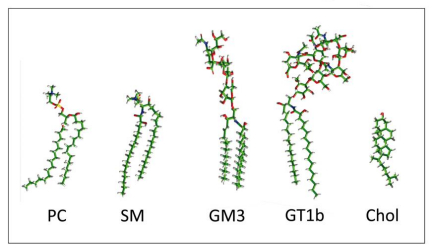
 DownLoad:
DownLoad: 